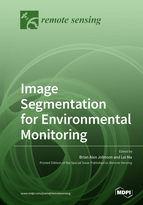Image Segmentation for Environmental Monitoring
A special issue of Remote Sensing (ISSN 2072-4292). This special issue belongs to the section "Remote Sensing Image Processing".
Deadline for manuscript submissions: closed (31 December 2019) | Viewed by 48674
Special Issue Editors
Interests: geographic information systems (GIS); remote sensing; spatial modeling; and data mining for urban and environmental analysis and planning; mapping urban land cover (green space; impervious surfaces; etc.); monitoring forest health using fine resolution satellite imagery
Special Issues, Collections and Topics in MDPI journals
Interests: remote sensing image information extraction; object-based image analysis (OBIA); machine learning or data mining with applications in remote sensing and geospatial analysis
Special Issues, Collections and Topics in MDPI journals
Special Issue Information
Dear Colleagues,
Image segmentation has become a major topic of interest in the environmental remote sensing field due to the ever-increasing quantity of high spatial resolution (HSR) imagery acquired from satellites, airplanes, unmanned aerial vehicles (UAVs), and other platforms. Image segmentation involves sub-dividing an image into homogeneous regions that ideally represent real-world objects of interest, and it has been shown to be particularly beneficial when the objects of interest in an image are larger than the image pixels, as is often the case with HSR images. Image segmentation is a fundamental component of geographic object-based image analysis (GEOBIA).
HSR data from various types of sensors, e.g., multispectral, hyperspectral, synthetic aperture radar (SAR), light detection and ranging (LIDAR), and thermal infrared sensors, are now becoming widely available. Additionally, a large and ever-growing archive of freely-available moderate spatial resolution imagery (e.g., Landsat and Sentinel data) also bring new challenges for segmentation and analysis of dense time-series imagery. Aside from the data acquired by traditional sensors, citizen sensor data, e.g., volunteered geographic information (VGI), has become yet another promising source of geo-data for environmental monitoring and analysis. Thus, new image segmentation and GEOBIA approaches that can effectively utilize these types of multi-sensor/multi-temporal data are particularly needed.
This Special Issue welcomes submissions representing advances in remote sensing image segmentation methods, strategies, and/or applications. Submissions may cover a wide range of topics including (but not limited to):
- Image segmentation algorithm development and evaluation
- Segmentation parameter selection and “optimization”
- Segmentation approaches for multi-source/multi-sensor data analysis
- Segmentation approaches for multi-temporal/time-series data analysis (e.g., vegetation phenology monitoring or land use/land cover change mapping)
- Segmentation approaches for big data analysis
Dr. Brian Alan Johnson
Dr. Lei Ma
Guest Editors
Manuscript Submission Information
Manuscripts should be submitted online at www.mdpi.com by registering and logging in to this website. Once you are registered, click here to go to the submission form. Manuscripts can be submitted until the deadline. All submissions that pass pre-check are peer-reviewed. Accepted papers will be published continuously in the journal (as soon as accepted) and will be listed together on the special issue website. Research articles, review articles as well as short communications are invited. For planned papers, a title and short abstract (about 100 words) can be sent to the Editorial Office for announcement on this website.
Submitted manuscripts should not have been published previously, nor be under consideration for publication elsewhere (except conference proceedings papers). All manuscripts are thoroughly refereed through a single-blind peer-review process. A guide for authors and other relevant information for submission of manuscripts is available on the Instructions for Authors page. Remote Sensing is an international peer-reviewed open access semimonthly journal published by MDPI.
Please visit the Instructions for Authors page before submitting a manuscript. The Article Processing Charge (APC) for publication in this open access journal is 2700 CHF (Swiss Francs). Submitted papers should be well formatted and use good English. Authors may use MDPI's English editing service prior to publication or during author revisions.
Keywords
- Image segmentation
- GEOBIA
- Remote sensing data fusion
- Object-based image classification
- Segmentation parameter optimization







